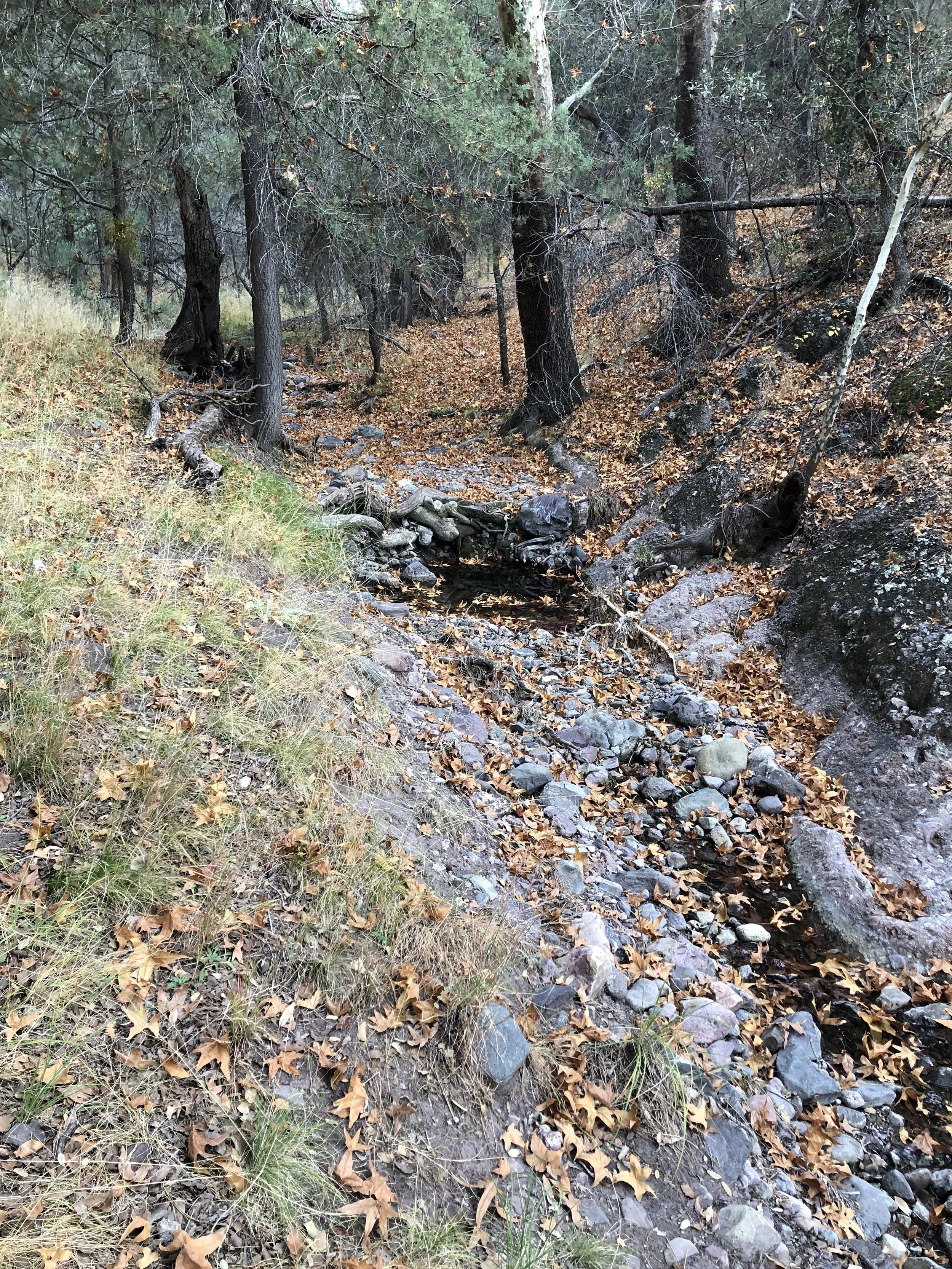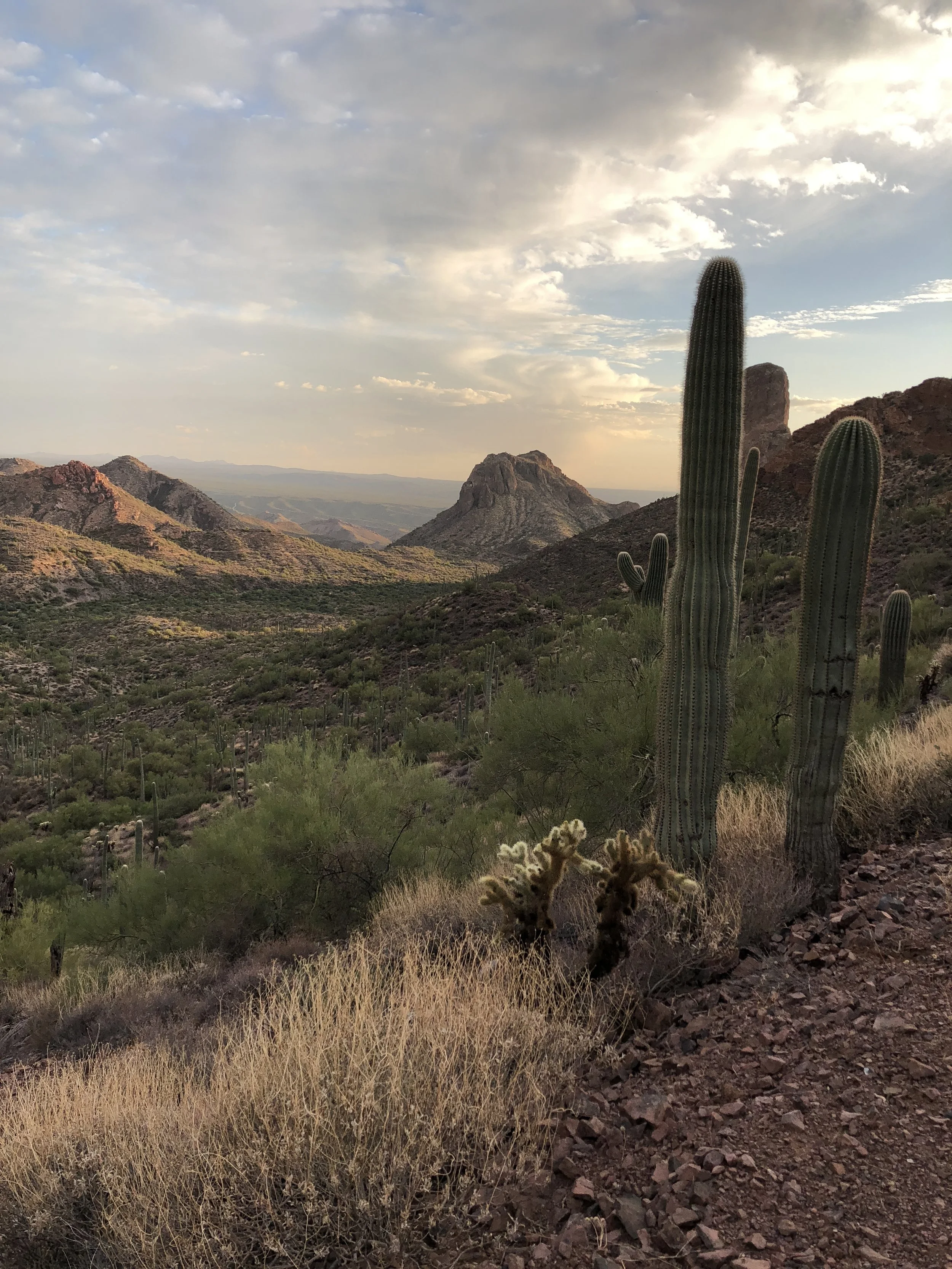Into the home stretch on the AZT!
Well in the last two weeks I made it to Patagonia, only 50 trail miles from the Mexican border! After exiting the trail for a weekend to attend a wedding with Janice in Austin, I hiked from Kelvin/Riverside (near Kearney) up Ripsey Wash, into the desolate cholla-infested hell of the Black Hills, and on to highway SR-77. I tried hitching into Oracle but failed dismally (see photo associated with this post and tell me if you can figure out why), so ended up walking into town. Famished and grouchy, I marched into the Oracle Inn where they graciously let me sit in the main dining room (not exiled out back or some such, given the way I looked and probably smelled) and ordered a steak and a Moscow Mule. What a treat!. A few days earlier I'd called Rancho Robles, where we'd had our annual Exploration Group meeting back in September, but it was booked solid with 75 Mary Kay sales ladies (kind of a scary thought). The owner recommended a place called the 3C Guest Ranch. I called and Connie, the proprietress, had room for me, agreed to pick up my resupply package at the post office before I arrived and, furthermore, even picked me up at the Oracle Inn and took me out to the 3C after I finished my steak. Wow! I was able to shower, launder my clothes, charge my electronics and actually stay up till 9 pm reading. The latter was a treat because its now getting dark around 5:30 pm. I usually finish up dinner by 6, hang up my bear bag, with all food and eating utensils in it out of reach of critters, then retreat into my tent and read. That rarely lasts past 7:30 or 8:00 pm, when my hands start to get cold, I turn off my headlamp and call it a night. It doesn't get light till 6:15 am or so, which means I've got 10 or 11 hours to kill. Now I'm a guy who rarely sleeps more than 7 hours at home, so this is a real trial and points to one of the multiple benefits of "modern" (post ice-age) culture: artificial light and warmth in a cozy, enclosed space (e.g. a cave or a cabin or my bedroom or a hotel room) and one of the big disadvantages of doing the AZT this time of year.
From there, on the advice of Connie and her husband, I went up Peppersauce Canyon and intersected the AZT on the ridge line of the Catalinas (a slight deviation from the official AZT) and saw one of the more comical vignettes of my pilgrimage. The canyon was packed with empty deer hunter's camps, given that at that hour of the morning they were out stalking their elusive prey. However, at least one group of deer had apparently figured out the hunter's schedule and was calmly browsing in and around the biggest camp I walked by!
Peppersauce led me up to the ridge line of the Catalinas, which I followed to Summerhaven. There I picked up a resupply package I'd mailed myself to the Mt. Lemmon General store, where Phil and his wife Carol welcome and take very good care of AZT hikers, then treated myself to another real dinner at the Sawmill Run Restaurant (hey, you gotta take advantage of a real meal wherever you can, right!). By the time I finished, it was getting dark and I walked to the Marshall Gulch AZT trailhead by the light of my headlamp. The only viable campsite there was occupied by a bunch of rowdy partiers, so I made the mistake of heading up the trail in the dark. Well I stumbled along and nearly twisted an ankle, or worse, a few times; passed a drunk and disorderly young couple trying to extricate themselves from the creek bottom, which shouldn't have been too difficult in more sober circumstances (I offered to help but they just giggled), till after a mile or so I came to a flat spot about the size of my tent and plopped down for the night. The next day's hike through the Catalinas was beautiful; I skirted the shoulder of Mt Lemmon and then descended into Sabino Canyon, where I camped at the most beautiful tinaja I've yet seen: Hutch's pool. Its about 25 yd x 5 yd and who-knows-how-deep, with a white sand beach on the end where I camped. The only downside was another darned skunk who was way too interested in my camp, but between my efforts and those of the girls camped just downstream, we managed to shoo him away.
I then traversed eastward through the El Molino campground, where Rich, the host, kindly topped up my water supply (he's got the cleanest, sweetest smelling outhouses in the state), walked another 6 mi and camped near the Bellota Ranch. Next morning the march continued over Reddington Pass Rd and to the foot of the Rincon Mountains. The latter present a formidable challenge, with a 4000' vertical climb in 7 miles. I struggled up to just below Mica Mountain and found a nice grassy saddle to camp in and watch a spectacular sunset with a panoramic view from the Catalinas to the Chiricahuas. The next day I watered up at Italian Spring, finished the ascent to the top of Mica Mountain, then descended the other side through beautiful piney woods past Manning Camp, Grass Hut Camp and finally back into the desert in the Vail, AZ area. I had another civilized rest at the Rincon Creek Ranch, hosted by Bill Shirley, resupplied at Colossal Cave, where a coati was cavorting by the snack bar, then emerged from beneath I-10 into the wonderland of SE Arizona.
My walk along the E flank of the Santa Ritas was magical: it is a wonderland of tall grass, scattered oak, juniper and mesquite trees cut by deep gashes like Gardner Canyon with at least a trickle of water in them. A red tailed hawk circled overhead and screamed at me (hi Dad!) at my second camp, I saw whitetail deer, migrating tarantulas and thought a lot about jaguars, though saw no sign of them. There were pleasant chats with other hikers and bikers and a nice stop for water and power at the old gold mining settlement of Kentucky Camp. Finally, from a high saddle between Walker Canyon and Temporal Gulch, I dropped down a long, pretty gentle decline into Patagonia.
Patagonia is one of these schizoid towns well along in the transition from old ranching and mining community to New Age art colony with eco-tourism overtones. I stayed at the Stage Stop Inn, ate dinner at the Wagon Wheel bar, both hold-outs of the former, but had coffee at The Gathering Grounds where representatives of the latter congregate. Again, it was wonderful to bask in artificial light and read a book (The Seven Sisters, a classic work on the evolution of the global petroleum industry that I'd had recommended to me years ago) till 9 pm in a warm room!
I'll be back to finish the last 3 days of the hike after Thanksgiving with the family in Mesa, meanwhile a final bit of barely-related historical trivia: what is the origin of the name of the sate of Arizona? Well, as best I can dig up it comes from the name of a ranch owned by Bernardo de Urrea, a Basque Spaniard, that was located on the Mexican side of the border, about 36 miles SW of Patagonia. A spectacularly rich deposit of native silver called Planchas de Plata, was discovered there in 1737, the fame of which led to the general area being baptized Arizona. "Toward the end of last October, between the Guevavi Mission and the ranchería called Arizona, some balls and slabs of silver were discovered, one of which weighed more than one hundred arrobas (2,500 pounds), a sample of which I am sending to you, Most Illustrious Lord. --Captain Juan Bautista de Anza to Bishop Benito Crespo, January 7, 1737. Apparently Arizona means "the good oak tree" in Basque.


